
Editor’s Note: Cheyenne Reyes graduated in May 2019 from the University of Louisiana Monroe Medical Laboratory Science program. She is employed with Ochsner LSU Health Shreveport-Monroe Medical Center in Monroe. Reyes was profiled recently by The American Society for Clinical Laboratory Science (ASCLS). The article is reprinted with permission from the ASCLS. Comments from ULM’s Jessica Lasiter of the Medical Laboratory Science program were added by the ULM Office of Marketing and Communications.)
From The American Society for Clinical Laboratory Science
While completing her degree in Medical Laboratory Science at the University of Louisiana Monroe, Cheyenne Reyes worked as a phlebotomist. This gave her a unique perspective of the laboratory through the eyes of phlebotomists.

Few people know the work done by medical laboratory scientists (MLSs). However, most people are aware of the nursing profession, and many know of phlebotomists. The reason is simple: patients see and communicate with them.
The symbiosis of phlebotomists and laboratory scientists is of substantial importance. In some places, the MLS collects their own specimens, but most of the time laboratory professionals depend on phlebotomists or nurses for collection.
However, each test must be performed on a patient’s specimen, most commonly his or her blood. If it weren’t for phlebotomists, the laboratory scientists would have to draw their own samples, leading to a delay in patient results.
Often, patient data is the sole reason for a diagnosis, and they are very time sensitive. Phlebotomists are depended up to collect quality samples that are transported to the lab quickly so tests can be performed as soon as possible.
Cheyenne Reyes: My experience as a phlebotomist
“As an MLS student, I was given a wonderful opportunity to be trained on the job and work as a phlebotomist while taking classes. Thanks to this job, I have gained an understanding of the laboratory that many of my peers have not experienced. During my time at work and in clinicals, I noticed some laboratory scientists pay little attention to what phlebotomists must deal with, which inspired me to pass out a survey to both phlebotomists and medical laboratory scientists.
“In my survey, several phlebotomists did not feel respected or appreciated by their laboratory scientists. Phlebotomists have expressed that MLSs ‘look at our title as nothing,’ even though ‘we are a major part of the lab.’ Some even feel as though they are viewed as working for the laboratory professionals, rather than with them," Reyes said.
Jessica Lasiter, ULM Associate Professor of MLS in the School of Allied Health, said all MLS students complete a clinical rotation for phlebotomy in at a hospital or clinic.
“The MLS student experiences the daily workload for a phlebotomist and the interaction between multiple disciplines in healthcare while completing their phlebotomy clinical rotation. Hopefully, after their phlebotomy clinical rotation, the MLS student will always remember and appreciate the specialized role of the phlebotomist,” Lasiter said.
Reyes continued, “While I am fully aware that samples must be held to a certain standard, we also must think about how many times that patient was probably stuck to get that 1mL of blood. The phlebotomists must go up to that patient and tell them they must try to draw blood again for the 16th time in an hour because the last sample was not good enough.
“If we need a recollect and their outpatient waiting room is full, we must have patience or be willing to help. Receiving samples from the pneumatic tube system, drawing outpatients, and answering the phone may not seem like a lot, until you are in the middle of it. They do not need a laboratory professional to ask them about another sample that needs to be recollected every five minutes.
“During my few years of work and school, I have met a variety of people working as medical laboratory scientists. They have bestowed upon me knowledge that can only come from many years of experience in the field.
“While some may be surprised to learn about the lack of respect toward phlebotomists, the results of this survey seem to indicate that the feelings of the phlebotomists are not unfounded.
“Many medical laboratory scientists firmly believe in aiding and thanking their phlebotomists. However, there are a few that believe phlebotomists ‘shouldn’t feel anything’ about their unwillingness to help because it’s the phlebotomist’s job, and ‘they will feel thankful if I’m willing to help,'" Reyes said.
“ULM's Medical Laboratory Science Program molds the students to respect all areas of healthcare including phlebotomy,” Lasiter said. “Phlebotomists are often the only personal contact a patient has with the laboratory. This key player in healthcare can leave a lasting impression on the quality of the laboratory and the entire health-care setting.”